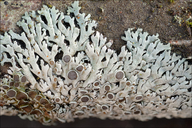|
|
click photo for larger file

Physcia aipolia
Hoary Rosette Lichen
|
Photographer: Dr. Amadej Trnkoczy
ID: 0000 0000 0218 0003 (2018-02-01)Copyright © 2018 Dr. Amadej Trnkoczy
|
|
INFORMATION PROVIDED WITH THE PHOTO
|
date of photo Jan 11, 2018
latitude 46.36026 longitude 13.70262
View on Google Maps.
location
Lower Trenta valley, right bank of river Soča; between villages Soča and Trenta; near Trenta 2b cottage, East Julian Alps (Posočje, Slovenia)notes Slo.: ? - syn.: Parmelia stellaris f. aipolia (Ehrh. ex Humb.) Hazsl., Xanthoria aipolia (Ehrh. ex Humb.) Horw. - Habitat: abandoned pastures with scattered trees; moderately inclined mountain slope, south-east aspect; relatively warm and dry place; calcareous ground, sunny place; exposed to direct rain; average precipitations ~ 3.000 mm/year, average temperature 7-9 deg C, elevations 600 m (1.950 feet), alpine phytogeographical region. Substratum: bark of smaller branches of a stand-alone, recently cut down Juglans regia. Comment: When dry Physcia aipolia doesn't seem very attractive lichen. It is monotonously whitish-gray or gray and blends well with grayish bark of tree branches and twigs. However, when wet its bluish or greenish colors pop out distinctly. Its dark and almost always abundant apothecia pup out from much lighter thallus and its distinctive maculae (white spots on greenish thallus) become very apparent. Physcia aipolia is quite a common lichen and has been recorded in Slovenian Alps many times (Ref.: 6, 7, 8). It can be distinguished from several other similar Physcia species by distinctive maculae, yellow K reaction of thallus and medulla and pale lower side of the thallus having pale rhizines. It is mostly growing on small and medium size branches of smooth barked trees. Ref.: (1) C.W. Smith, et al, The lichens of Great Britain and Ireland, The British Lichen Society, (2009), p 700. (2) I.M. Brodo, S.D. Sharnoff, S. Sharnoff, Lichens of North America, Yale Uni. Press (2001), p 549. (3) V. Wirth, Die Flechten Baden-Württembergs, Teil.1. 2., Ulmer (1995), p xx. (4) F.S. Dobson, Lichens, The Richmonds Publishing Ca.LTD (2005), p 338. (5) https://www.123pilze.de/DreamHC/Download/Ziegen-Schwielenflechte.htm (accessed 1.2.2018) (6) Boletus Informaticus Database, Forestry Institute of Slovenia http://www.zdravgozd.si/bi_index.aspx (accessed 1.2.2018) (7) Prügger et all. 'Alphabetical list of lichenized fungi for the six phytogeographical regions of Slovenia', http://members.chello.at/johannes.pruegger/uni/slovenia/ (accessed 1.2.2018) (8) F. Batič, K. Primožič, B. Surina, T. Trošt & H. Mayzhofer, Contributions to the lichen flora of Slovenia X. - Contributions to the lichen flora from the Slovenian Julian Alps, Herzogia 16, (2003): 143–154camera Nikon D700 / Nikkor Micro 105mm/f2.8
contributor's ID # Bot_ 1102/2018_DSC9818 photo category: Fungi - lichen
|
MORE INFORMATION ABOUT THIS FUNGUS
|
| common names
Hoary Rosette Lichen (photographer)
View all photos in CalPhotos of Physcia aipolia Check Google Images for Physcia aipolia |
|
The photographer's identification Physcia aipolia has not been reviewed. Click here to review or comment on the identification. |
|
Using this photo The thumbnail photo (128x192 pixels) on this page may be freely used for personal or academic purposes without prior permission under the Fair Use provisions of US copyright law as long as the photo is clearly credited with © 2018 Dr. Amadej Trnkoczy.
For other uses, or if you have questions, contact Dr. Amadej Trnkoczy amadej.trnkoczy[AT]siol.net. (Replace the [AT] with the @ symbol before sending an email.) |
|
|
